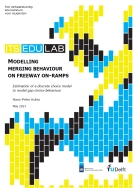Microscopic traffic simulation models are a widely used tools for transport system analysis and management. These tools are used to model the complexity of the systems and to evaluate various traffic management alternatives in order to determine the optimal solution for any traffic scenario. A classical way to represent vehicle interactions at merges at the microscopic scale is to combine a gap-acceptance model with a car-following algorithm. With the gap acceptance the choice for a certain gap is modelled. Recently a new concept framework for modelling merging behaviour was proposed. This concept is based on gap selection. The choice decision of a gap out of a set of offered gaps is the main focus for the research described in this report.
With an empirical data analysis at a freeway on-ramp the merging behaviour and gap choice behaviour is analysed. The factors analysed with the empirical dataset are the average speed per lane, the speed during the merge on the shoulder lane, the driving behaviour on the acceleration lane and the gaps. Besides the merging behaviour, also an empirical analysis of the gap choice behaviour is performed. From this analysis it is clear that different gap choice behaviour occurs in different traffic states and different vehicle types. Therefore different choice models are estimated.
The findings of the state-of-the-art and empirical data analysis about merging behaviour are compared with the results of the simulation tool FOSIM. In FOSIM vehicles are merging much earlier. Also, during congestion the average speed per lane differs a lot between FOSIM and the empirical data. There seems to be no interaction between the lanes in the simulation results of FOSIM. Three choice models are estimated, namely a choice model for HGV’s, passenger cars in free flow and passenger cars in congestion. With these three models a face validation is performed on two aspects, namely an aggregate validity test and validity test per individual. The aggregate face validity of the three choice models is good. The validity test per individual was not as good as the aggregate validity. This means the discrete choice models in general models the right gap choice distribution, but per driver, the predicted gap and the actually observed gap are not the same.
From the research it is concluded that gap acceptance models do not simulate the merging behaviour accurately. In these kinds of models only one gap at the time and only the gap size is evaluated. But most of the time a driver is not merging into his nearest gap. It can be concluded that some drivers are choosing a gap further ahead and sometimes even two gaps further ahead, especially during congestion. The proposed discrete choice models are evaluating several gaps at once and take more characteristics into account for choosing a gap. Therefore it can be concluded that the three discrete choice models presented in this master thesis research are good models to model actual observed merging behaviour on a freeway on-ramp.
